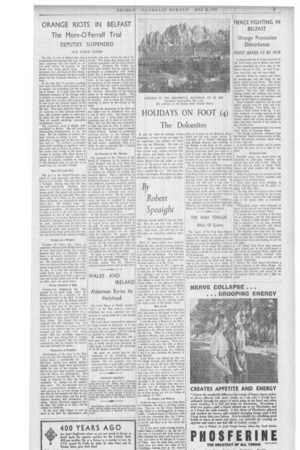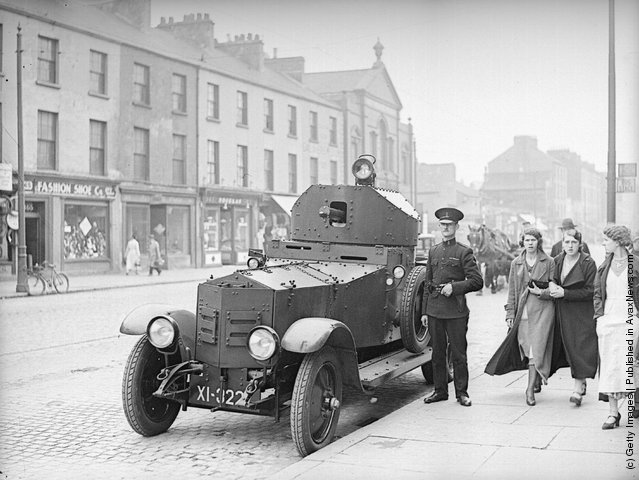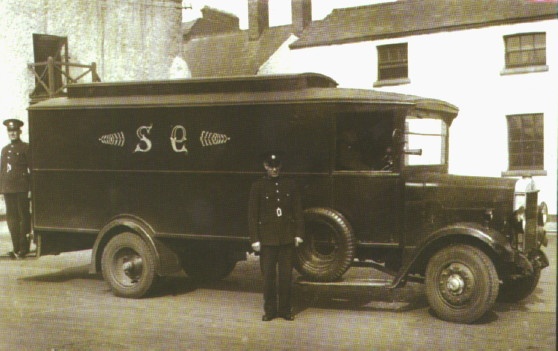July 1935: ‘Remember Belfast – Boycott the Orangemen!’

July 1935 saw vicious sectarian rioting in Belfast. Here in a follow up to his article on the riot in Limerick, Brian Hanley looks at the ripples the disturbances created throughout southern Ireland.
Late July 1935 saw an unprecedented wave of anti-Protestant activity in the Irish Free State. Emotions ran high after a week of violence in Belfast where several people were killed and dozens injured in rioting after Orange parades. Catholics were forced from their homes and workplaces and several were killed. As riots and gun battles raged, many nationalists begged for action from the Free State and British governments to protect them.
In the midst of this an anti-Protestant riot took place in Limerick city on 20th July, while in Galway a few days later workers took strike action demanding Protestants be dismissed from their jobs. Sectarian incidents were reported from 19 counties in the Free State altogether, though these varied dramatically in intensity. By early August this wave had subsided, leaving barely a trace that it had ever occurred.
‘Orangemen beware’
In Letterkenny, Co. Donegal, at 6am on the morning of 16 July, the Donegal Service Depot, a Protestant owned motor business, was destroyed in an arson attack. The windows of five Protestant owned shops in the town were also broken in the same incident. During the early hours of Monday 22 July the Anglican church in Kilmallock, Co. Limerick was burnt down, while the windows of the local rector’s home were smashed along with those of a Protestant owned shop.
The riots in Belfast provoked a series of arson attacks, threats and intimidation against Protestants in southern Ireland.
That weekend also saw several arson attacks in Clones, Co. Monaghan. The town’s Masonic Hall was completely gutted, while extensive damage was done to a gospel hall used by the Plymouth Brethren and to the Pringle Memorial Hall (a Protestant social club). A bakery owned by a local Protestant councillor also had its windows broken.
Over the next few days there was an arson attack on the Methodist Church in Boyle, Co. Roscommon, an attempt to burn the Masonic Hall in Kells, Co. Meath and four cottages belonging to Protestants were set on fire in the Corran area of Co. Cavan.
Rifle shots were fired into the homes of two elderly Protestant farmers in Clogher, Co. Tipperary. A shotgun was discharged at the Bank of Ireland in Listowel, Kerry, whose Protestant manager and his family lived over the premises. There was another attempted arson at a Protestant church in Kilnaleck, Co. Cavan. In Limerick city windows were smashed in the Presbyterian Church (which had survived an arson attempt during the riot the previous weekend). Windows were also broken in a Protestant Church in Trim and in the Masonic Hall in Athlone.
In Bray windows were smashed in the Men’s Institute on Main Street (known locally as the ‘Protestant Hall’) and two teenage Protestants were assaulted by a gang who first asked them what their religion was and then called them ‘dirty Protestants’ and ‘Orangemen.’[1]
During the same period anti-Protestant slogans appeared in several areas. ‘Remember Belfast’ was painted on Protestant property in Ballina, Co. Mayo, along with the claim that the ‘Orange shops of Ballina take the Catholic money and smile on.’ In Monaghan inscriptions such as ‘The South will settle Belfast’, ‘Boycott Orangemen’ and ‘God bless the Pope’ were painted on roads around Castleblayney.

On the main street of Ballybay the legends ‘Orangemen beware’, ‘Faith of Our Fathers’ and ‘Will Ballybay stand and see Catholics shot in Belfast?’ appeared. ‘Remember Belfast’ was painted on four Protestant homes in Athboy, Co. Meath. Similar slogans also appeared near Protestant businesses in Enniscorthy, Co. Wexford.
In Dunmanway, Co. Cork, the slogan ‘Remember ‘21-watch Belfast’ was painted on the roads. In Castlepollard, Co. Westmeath, bills warning that ‘if this trouble in Belfast goes on much longer we will be compelled to make it hot for you so look out for trouble’, were posted at the Anglican Church and rectory.
Threatening letters
Threatening letters were delivered to Protestant businesses in various parts of Monaghan, typical among them the assertions that ‘We don’t want you or your Orange bastards in the Free State’ and ‘if you are wise better look for a job in the Six Counties, where you don’t like our Pope. Bullets and grenades are cheap.’[2] Several of the letters added an extra barb by ending with the warning ‘Beware the IRA.’ Threatening letters in the IRA’s name were common in Ireland during the 1930s but in most cases there was no evidence that the IRA actually sent them. [3]
Several threatening letters claimed to be from the IRA but that organisation assured Protestants it had not sent them
Two Protestant bank officials in Dunmanway received letters giving them a ‘First and final warning: we ask you to appeal to your Brethren in the North for the protection and salvation of our Catholics. If murder is continued you shall also share the same faith [sic]. Reporting to the Police is dangerous.’[4]
There were other examples of intimidation, some minor, like an attempt by a drunk ex-Free State Army officer to post up handwritten notices calling for a boycott of Protestants in Killaloe, Co. Clare. A shot fired at a Protestant clergyman’s car in Wexford turned out to have been accidental (and was accepted by him as such). The breaking of a window in a church at Frenchpark, Co. Roscommon was believed by Gardaí to be the work of local poitín makers, intent on diverting attention from their activities.[5]
Gardaí suspected that some claims were fabricated, describing a Kilkenny businessman, who claimed to have received a threatening letter as ‘a Protestant and a very bitter one’ who was intent on gaining special protection.[6]
‘Un-Irish crimes’
As soon the attacks began, Gardaí across the Free State were ordered to devote extra resources to guarding Protestants and their property. They were also successful in quickly discovering the source of many of the attacks. There was little evidence of popular support for the incidents which were universally denounced as ‘Un-Irish crimes’ that were ‘foreign to the Irish race and religion.’[7]
Many local bodies echoed the abhorrence of Tralee Urban Council at these ‘acts of primitive savagery.’[8] Fianna Fáil Minister for Finance Seán MacEntee asserted that anyone convicted of ‘such hooliganism would receive the full weight of the law and if necessary special powers would be taken to put down and suppress that terrible thing that had made itself manifest here.’[9] The general reaction from Protestants was to stress how much of an aberration the attacks were and claim that they received no persecution in the Free State.[10]

Nevertheless there was some evidence of unease. In Carrickmacross Gardaí felt ‘the Protestant population…are rather apprehensive owing to the present tension resulting from the Belfast disturbances.’[11] Reports also suggested that past fears might be revived by the attacks. In Dunmanway a Garda noted how ‘on a former occasion when trouble broke out in Belfast in 1922, three members of the Protestant community were taken from their homes and shot as a reprisal’ and felt that the latest incidents might ‘cause a scare in Protestant circles in Dunmanway.’[12]
Who was responsible?
Given that the attacks were so widely condemned who was responsible for them? Evidence supports the Garda contention that they were not carried out by ‘any particular or central organisations’ and that ‘local trade or petty jealousies’ played a part in some of them.[13] In many cases small groups had been discussing the Belfast events, often after drinking, and decided to seek revenge on the nearest available Protestant target.
The three men arrested for the Kilmallock attacks had been talking about what was happening in Northern Ireland at a hurling match on Sunday 21st. It was alleged that one said there had been ‘great work in Limerick the previous night’ (a reference to the city’s riot) and suggested ‘we will burn them out.’[14] In Kells young men had discussed ‘burning the Masonic Hall on account of the Protestants killing the Catholics in Belfast.’[15]
Garda contention was that the incidents were not carried out by ‘any particular or central organisations’ and that ‘local trade or petty jealousies’ played a part in some of them
In Trim the culprits had ‘a good deal of drink taken’ before they smashed a window in the local Protestant church.[16] When Gardaí in Bray apprehended the gang who had assaulted the Protestant youths, they admitted to breaking the windows of the Men’s Institute as well.[17] In Athlone an ex-soldier claimed that breaking a window in the Masonic Hall was his protest against ‘the Imperial Government…for the treatment of Catholics in Belfast.’[18]
Members of the Catholic Young Men’s Society, returning from a dance in Enniscrone in the early hours of the morning were suspected of having painted the slogans on Protestant owned shops in Ballina.[19] In Ballybay a group of local youths from a variety of political backgrounds were thought to have been behind the sectarian inscriptions. In Dunmanway three young republicans were suspected of sending the threatening notes. This was on their own initiative and local IRA officer Tadgh Lynch had called to a Protestant clergyman in Dunmanway to assure him that his organization did not approve of the threats.[20]
In Listowel the Gardaí initially assumed the local IRA were involved but in fact it was members of the League of Youth (Blueshirts) who had decided to ‘frighten’ the bank manager by firing on his home.[21]
Blueshirts were also responsible for the shooting incidents in Tipperary, though there were deeper roots to that incident. One of the victims, Richard Pennefather, was a substantial farmer who had ‘got a lot of trouble in the years 1922 and 1923’ when a number of Pro-Treaty IRA men from nearby Turraheen had fired shots into his home, broken his windows and commandeered his car on several occasions.
Members of the Blueshirts were responsible for the two shooting incidents that took place but there may also have been local grievances involved.
Their intention was to force him out and gain from division of his land. By 1935 the same group were at the core of Blueshirt activity in that part of Tipperary. Gardaí noted that while Pennefather had amicable relations with Fianna Fáil supporters he had ‘every reason to hate’ the Local League of Youth from whose members he had ‘got such persecution in 1922.’[22]
There was also a suggestion of self-interest in the Letterkenny case. Driving several people back from a dance in Ramelton, a man named Bernard Sweeney raised the events in Belfast and proposed taking some action. Only one other man agreed to help him however and Gardaí believed Sweeney was at least partly motivated by the fact he owed over £34 to the garage that he set on fire. Nevertheless when Sweeney and another suspect appeared in court they were applauded by youths who patted them on the back and shouted ‘up the Republic.’[23]
In contrast, the Clones incidents involved up to 20 men. Gardaí believed a meeting to plan them had taken place and the burnings were executed simultaneously with a degree of organization not apparent elsewhere. Some of those involved were thought to be from Northern Ireland and when suspects were questioned they had prepared alibis. Gardaí even claimed some people in the town were ‘terrified of the gang responsible.’ No organization was identified as involved.[24]
Spontaneous or planned?
One of the few attempts to analyze the events came from the Republican Congress. They claimed that the ‘pogroms had crossed the border’ and stated that ‘victimisation of Protestant workers (and) cowardly attacks on Protestant property’ should be ‘immediately stopped and the ringleaders brought to book.’[25] The Congress newspaper suggested that the incidents in Monaghan could ‘be traced to the sectarianism which is inevitable when two such rival bodies as the Ancient Order of Hibernians and the Orange Order flourish side by side.’
Certainly there was an edge to sectarianism where there were large Protestant minorities, active Orange Lodges and a tradition of Protestants employing ‘their own.’ But in Monaghan several of the firms targeted by threatening letters had mixed workforces and Garda reports stressed that those targeted were on good terms with their neighbours and that ‘harmonious’ relations between the communities was the norm.
Indeed in Ballybay while the ‘conditions in Belfast (were) keenly felt…restraint (was) strongly advocated by all sides.’[26] Nor was there any evidence produced that the Hibernians were involved in the incidents. The biggest sectarian mobilisations actually took place far from the border in Limerick and Galway, while there were several incidents in areas with tiny Protestant populations. It is also interesting that no attacks of any note occurred in Dublin or Cork city despite both places having relatively large and visible Protestant populations. Aside from the breaking of a window in a gate lodge belonging to Lord Daresbury at Mount Coote near Kilmallock, neither were any of the attacks directed at the Anglo-Irish landed gentry.
Dublin and Cork cities, which had the largest Protestant populations in the 26 counties, saw no incidents of note.
In most cases the actions were spontaneous or semi-spontaneous, based on a desire to avenge the persecution of Catholics in Belfast. What they also showed was that some believed that southern Protestants had a responsibility for the actions of their co-religionists in the North. This view was shared by many who rejected violent action against Protestants.
Reactions
A motion from Youghal Urban Council, supported by local bodies in other areas, claimed to hold Protestants in the ‘greatest esteem and respect’ but also asked ‘the Protestant people of the South to remain no longer silent…we ask that they protest…against the vile and barbarous attacks on the Catholic people of the North.’[27] Similarly when protesting against attacks on Catholic workers Wexford Trades Council made clear that they ‘would like to hear the Protestants of Wexford raising their voices against such outrages.’[28]
The private reaction of those targeted was also interesting. Some of those who received threats in Monaghan requested Gardaí not to pursue investigations as ‘it might cause ill-feeling.’[29] In Dunmanway Gardaí conceded that the case would not be solved because of the ‘injured parties and the Protestant community generally endeavouring to hush the matter up. They are of the opinion that the solving of this crime would start trouble and create a split between them and their Catholic neighbours which would last for years.’[30]
Protestants it seemed, were eager to let the matter rest. Though there was little popular enthusiasm for anti-Protestant agitation it proved difficult to secure convictions against those involved in the Kilmallock and Letterkenny incidents. Rumours soon circulated that the son of the local Anglican rector had insulted nuns in Kilmallock and that this was the cause of the affair.[31] Gardaí privately admitted the juries were reluctant to convict those accused of actions with a ‘sectarian or political colour.’[32]
Gardai found the, ‘Protestant community generally endeavouring to hush the matter up. They are of the opinion that the solving of this crime would start trouble and create a split between them and their Catholic neighbours which would last for years’
In the case of the Limerick riot, the city’s mayor and senior Catholic clergy lobbied Gardaí during the autumn of 1935 asking that remaining court cases be abandoned because they might ‘revive the bitterness and ill-feeling which have now died down.’[33] Within a short space of time the most widespread examples of anti-Protestant activity in the Free State’s history had been largely forgotten. [34]
References
[1][1] The attacks were covered extensively in national and local newspapers during July 1935. Press cuttings relating to these cases are contained in Jus 8/418 National Archives of Ireland. Garda reports are contained in Department of Justice 2008/117/565-67 NAI.
[2] Garda reports, 23 & 25 July 1935.
[3]. B. Hanley, The IRA, 1926-1936 (Dublin, 2002). p. 42.
[4] Garda report, 23 July 1935.
[5] Garda reports, 21 July, 26 July & 1 August 1935.
[6] Garda report, 19 July 1935.
[7] Irish Independent, 22 July 1935 & Irish Press, 23 July 1935.
[8] Irish Times, 24 July 1935.
[9] Connaught Telegraph, 27 July 1935.
[10] See also letter from Reverend Kenneth Duggan in Westmeath Examiner, 27 July 1935.
[11] Garda report, 24 July 1935.
[12] Though Gardaí suggested that there was no evidence of this scare as yet. Garda report, 23 July 1935. The actual figure for the 1922 killings was of course higher. John Dorney, ‘Peter Hart and the Dunmanway killings controversy’ The Irish Story, 1 November 2011.
[13] Garda report, 24 September 1935.
[14] Limerick Leader, 11 & 13 November 1935.
[15] Garda report, 31 October 1935.
[16] Garda report, 31 August 1935.
[17] Garda report, 18 July 1935.
[18] Garda report, 26 July 1935. Ironically the man described himself as a supporter of the avowedly anti-sectarian Republican Congress.
[19] Garda report, 19 July 1935.
[20] Garda report, 12 November 1935.
[21] Garda report, 27 July 1935.
[22] Garda report, 31 July 1935.
[23] Irish Press, 22 July 1935.
[24] Garda report, 20 August 1935. The IRA were not suspected.
[25] Republican Congress, 27 July 1935
[26] Garda report, 17 July 1935.
[27] The Anglo-Celt, 27 July 1935.
[28] Irish Times, 27 July 1935.
[29] Garda report, 25 July 1935.
[30] Garda report, 31 December 1935.
[31] Limerick Leader, 10 August 1935.
[32] Garda reports, 26 October & 15 November 1935.
[33] Garda report, 26 October 1935. Nevertheless seven young men were jailed in November for their part in the trouble. Limerick Leader, 9 November 1935.
[34] The events are mentioned in Conor Foley Legion of the Rearguard: the IRA and the Modern Irish State (London, 1992) p. 155 and Tim Fanning, The Fethard-On-Sea Boycott (Cork, 2010) p. 7-8.